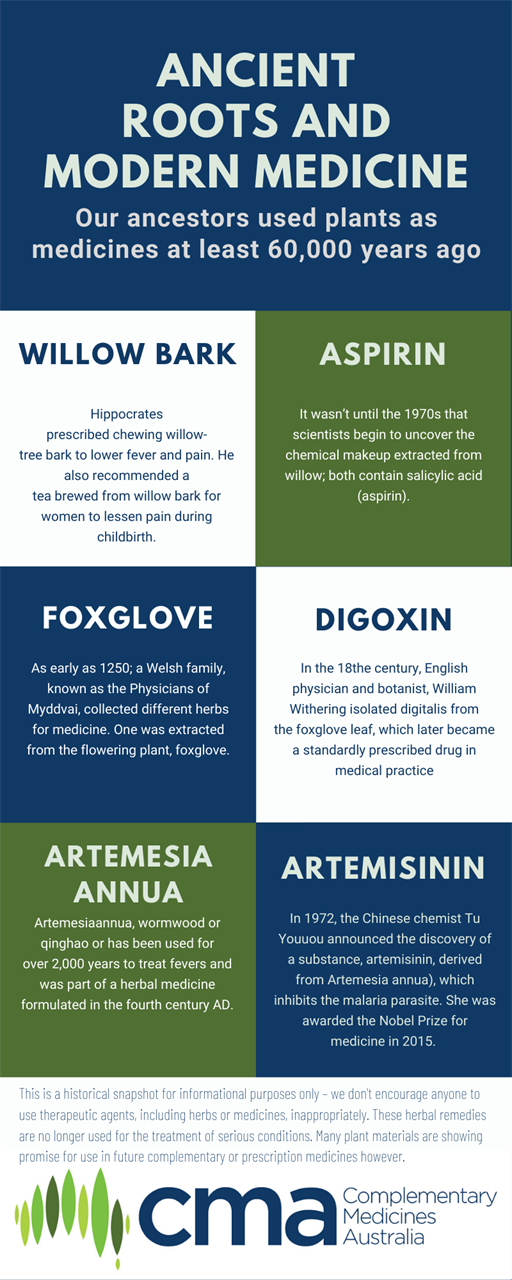Our ancestors used plants as medicines at least 60,000 years ago. Several ancient remedies are now used as conventional medicines – here are three of them.

Ancient roots: willow bark
The ancient physician considered to be the father of modern medicine, Hippocrates (460–370 BC), described many diseases and their treatment. He prescribed chewing willow-tree bark to lower fever and pain. He also recommended a tea brewed from willow bark for women to lessen pain during childbirth.
Modern medicine: aspirin
It wasn’t until the 1970s that scientists begin to uncover the chemical makeup extracted from willow; it contains salicylic acid a pre-cursor to aspirin (methyl salicylate).
Sir John Robert Vane FRS (1927-2004), an English pharmacologist, led the way to the understanding of how aspirin produces pain-relief and its anti-inflammatory effects. New treatments for heart and blood vessel disease and the introduction of ACE inhibitors were developed as a result of his work. He was awarded the Nobel Prize in Physiology in 1982.
Ancient roots: foxglove
As early as 1250, a Welsh family, known as the Physicians of Myddvai, collected different herbs for medicine. One was extracted from the flowering European plant, foxglove. The flowers can be fitted over the tip of a finger (digit) which relating to the scientific name Digitalis purpurea, given to the plant by German botanist Leonard Fuchs in 1542.
Modern medicine: digoxin
In the 18the century, English physician and botanist, William Withering, isolated digitalis from the foxglove leaf, which later became a standardly prescribed drug in medical practice. It was used to primarily treat “dropsy,” which medical texts explain as a cardiac malady causing irregular or weak heartbeats. Affected patients’ drowned’ in their fluids due to the build-up oedema.
In the 1800s, William Withering went on to publish a monograph describing the clinical effects of the extract of the foxglove plant.
Later, in the twentieth century, health practitioners linked foxglove and congestive heart failure (CHF), and medicines derived from the plant were then developed into prescription drugs.
One of the active ingredients is digoxin, a cardiac glycoside, was approved by the USA’s FDA in 1954.
Ancient roots: wormwood (Artemesia annua)
For more than 2,000 years, it has been used to treat fevers and was part of a herbal medicine formulated in the fourth century AD. Wormwood or qinghao is derived from the Asian plant Artemisia annua, an aromatic plant with fern-like leaves and yellow flowers. In 1596, Li Shizhen recommended a tea made from qinghao to treat malaria.
Modern medicine: Artemisinin
In 1972, the Chinese chemist Tu Youyou announced the discovery of a substance, artemisinin, derived from Artemesia annua, which inhibits the malaria parasite. This discovery saved millions of lives and earned Tu Youyou the Nobel Prize for medicine in 2015.
Note
This article is a historical snapshot and for informational purposes only – we do not encourage anyone to use therapeutic agents, including herbs or medicines, inappropriately. These herbal remedies are no longer used for the treatment of serious conditions. However, many plant materials continue to show promise for use in future complementary or prescription medicines.
References
1 https://www.ncbi.nlm.nih.gov/pubmed/15685783
2 See https://www.who.int/traditional-complementary-integrative-medicine/about/en/
3 Shi Q.W., Li L.G., Huo C.H., Zhang M.L., Wang Y.F. Study on natural medicinal chemistry and new drug development. Chin. Tradit. Herb. Drugs. 2010;41:1583–1589



